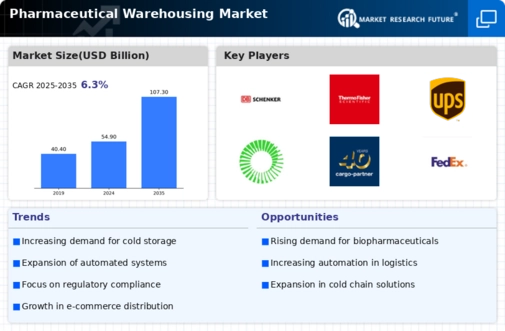Market Trends
Key Emerging Trends in the Pharmaceutical Warehousing Market
The pharmaceutical warehousing sector is going through a series of noticeable changes and trends, with a major aspect being the health area. Because of new technologies, changing government regulations, and the lasting effects of the COVID-19 epidemic, pharmaceutical firms are now reviewing their supply chain approach. The main market trend that can be observed here is the widened interest towards using state-of-the-art technologies for the reconstruction of warehouses. Organizations are taking into account modern automation systems, robotics, and artificial intelligence to impact efficiency, accuracy, and overall operations.
Increasingly, a pharmaceutical warehouse's attitude towards compliance and security is elevated in the processes of reconstruction. Like the rest of the pharmaceutical industry, companies operating in the warehousing sector should follow strict regulatory standards in order to ensure that their warehouses meet the requirements. Such activities include temperature-controlled storage, real-time monitoring, and market leading quality control systems. The reconstruction of the pharmaceutical warehouses is not only about building additional physical infrastructure, but also about making the entire supply chain more resilient and preventing risks to avoid the loss of integrity of pharmaceutical products.
Finally, it is the increasing demand for personalized treatments and the emergence of biopharmaceuticals that heavily influences the development patterns in pharmaceutical warehousing. The needs for the storage and handling of biological and specialty drugs are different from conventional pharmaceutical products making companies to be guided to redesign their warehouses appropriately. This pattern is pushing the architect and creation of facilities which are enriched with cold chain management systems in order to ensure the integrity of the temperature-sensitive biopharmaceutical products.
Covid-19 pandemic has too accelerated some aspects in market trends to which pharmaceutical warehouses reconstruction is subject. The reality has enforced companies to go an extra mile in terms of infrastructure in order to hold vaccines, drugs, and medical supplies, hence widening the size of their warehouses. Furthermore, COVID-19 has demonstrated the need for supply chains to be more adaptive, which has pushed companies to put money in mobile and modular warehouse structures that can easily adjust to different situations.
The environmental sustainability movement has prompted pharmaceutical warehouse rebuilding to dissolve into green practices. Nowadays, businesses are going green by installing green technologies e.g. efficient energy lighting or solar panels and eco-friendly packaging materials to limit their carbon footprint. That trend depicts an increased interest within industry to sustainable development and responsible business behaviour.












Leave a Comment